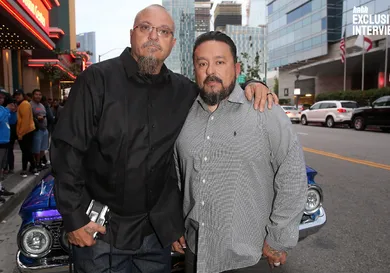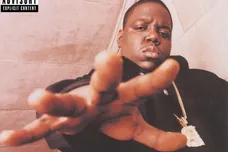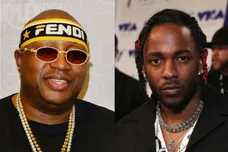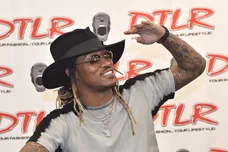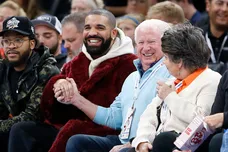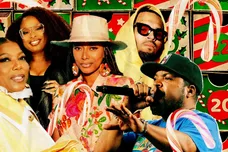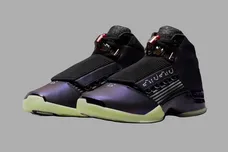“That violence, that poverty, that madness spawned a beautiful art form,” Mister Cartoon says in Netflix’s L.A. Originals. “Those guys sitting in cells that will never get out helped shape an art form. This rose out of the crack in the concrete.”
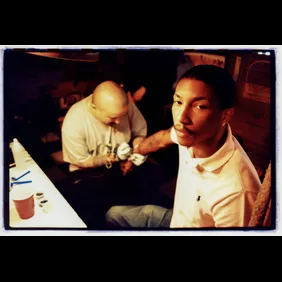
Mister Cartoon and Estevan Oriol have captured the world of East Los Angeles and beyond for nearly 30 years. Cartoon’s stylistic choices merge the worlds of jail artwork and graffiti together while Estevan has captured still moments in some of the rawest and chaotic environments. Their work has influenced a generation of artists and photojournalists that followed but more importantly, it gave the world insight into East L.A. from their perspective. A world that balances the beauty and resilience of Chicano culture and the bleak reality of L.A.’s underworld.
The distinctive art style that comes from East L.A can be attributed to their work throughout the 90s and 2000s. Netflix’s L.A. Originals delivers a candid look into their illustrious careers with unreleased behind-the-scenes footage from their work with 50 Cent, Dr. Dre, and Eminem as well as glimpses from the S.A. Studios era in Los Angeles’ Skid Row area.
L.A. Originals has been in the making for a few years but its actual release arrived months after the tragic death of Kobe Bryant and days after the one-year anniversary of Nipsey Hussle’s murder. Kobe, who was interviewed for the documentary months before his passing, was tattooed by Mister Cartoon. A notable photo of a young baby faced Nipsey Hussle in the streets of Crenshaw has inspired murals across the globe. Estevan took that photo.
Tattoos get carried to the grave while photos immortalize moments. And as much as Estevan and Cartoon carry on the legacies of others through their work, it’s their subjects that allow their artwork to live beyond the grave.
“I’ll do like a back piece for my friend and you know, one of my buddies, he OD’d and they take your artwork into the box, you know what I’m saying? It lasts longer. They might have some jewelry on, they might have some other things -- clothes or something to ‘em. But it’s a trip that your actual artwork is going to go back into the earth,” Toon told HNHH. “And you know, sometimes, Estevan captures these guys so we have their picture. It’s a little bit of our way of, kind of, putting our flag into the ground, you know what I mean? Kind of just saying, ‘we were here.’ This is tribal for us. Kind of like an Aztec Warrior carving on the side of a pyramid, you know? It’s our way of leaving our mark.”
Following the release of L.A. Originals, Estevan Oriol and Mister Cartoon chopped it up with us about the making of the documentary, Chicano artwork in the Trump era, and working with Kobe Bryant and Nipsey Hussle.
This interview was lightly edited for clarity.
HotNewHipHop: How’re you doing, man? How are you holding up in the midst of this craziness?
Mister Cartoon: Well, I mean, I don’t wanna act like I’m having too much fun but if the government tells me to stay home and smoke weed again, I’m just gonna take orders from the government, you know?
Bro, I feel that 100%. That’s exactly how I felt about this whole thing.
MC: (Laughs) Nah I mean, what I do, my artwork, I’m in isolation. If I have my friends around, I can’t concentrate. They start telling stories. There’s time for that. And then there’s times for me to be in solitude and get work done. So, it’s actually a real positive thing in the midst of a lot of negatives for other people, you know.
*Estevan Oriol joins call*
Hey, nice to talk to you, man.
Estevan Oriol: Yeah, nice to talk to you too.
Thank you guys so much. Estevan, how are you doing?
EO: I’m doing pretty good.
Excellent, so now that I have both of you here I just want to congratulate you guys on the documentary. It was really dope just to get an insight into the work you guys have done over the years. How’d you guys hook up with Netflix to bring this documentary to life?
EO: We got signed to a production deal with Sebastian Ortega. He has a production company called Underground. He has one of the biggest running Netflix shows in Argentina. It's called El Marginal, and he came up here to meet somebody and met with me along the way, and I took him over to meet Cartoon at this photoshoot we were doing. He has one of the only lowriders in Argentina. He might have the only lowrider in Argentina and he’s all sleeved down. He wears Dickies and a T-shirt and Chucks to work and he’s a film exec. I was like, “Man, this guy is perfect, he gets it.” There’s no pitch or anything like that. It’s more like he said, “Hey, whatever happened to that doc? You know, if you guys want, I’ll do it for you.” And he walked us into Netflix and you know, it got signed right then and there.
That’s dope, especially since a lot of it is unreleased footage. How’d you guys, through all that 25 years of footage, skim through all that and decide what was going to be used and what wasn’t?
EO: Well, that was probably the hardest part of making the film. To me, I think the hardest part of anything is the editing. And you know, because for me, I shoot so much, like, I don’t shoot a bunch of dead footage. I just shoot like selected good stuff. So, I had 25 years of good footage and you know, the same with the photos. Our original goal was to try to do something like The Defiant Ones. We wanted to do like a four-part docu-series cause we thought we had enough footage that big and that long. But, we got just the 90-minute deal, so we ran with that and we just had to pick the highlights of all the footage and all the photos throughout the years and that was one of the hardest parts. A lot of people didn’t make it and a lot of good footage didn’t make it, but you know that’s all we could do in those 90 minutes.
Obviously this documentary goes through the highs and lows of your career, were there any scenes or footage that were particularly difficult to watch?
EO: Hmm, not really. For me, I saw the movie about 20 times before it got to the point where it’s at, so I had seen that footage over and over and over again. Maybe, the first time watching something, you’re like, “Oh, whoa.” But after seeing it a bunch of times, you’re kind of numb to it. For me, we didn’t really put too much of the hardcore stuff in there. There was a lot of stuff we held back on for, you know, reasons of, like -- if you put too much out there, then people are gonna be judging you and stuff like that. And we still have to work and we got families and all that so we didn’t want to just put it all out on the line and just be like, you know, “Here’s us, take it how you want.” There might be a repercussion of some kind of stuff like that if you’re planning to be out there in the workforce, getting work and stuff like that because might judge you and be like, “Oh you know, he’s the guy that was doing this or that.” So, there’s a lot of stuff, you know, [that] we just kept to ourselves.
Fair enough. I guess my follow-up would be what was your favorite moment from the documentary that you were excited to have the world to see?
MC: I think the type of footage backstage that, like, even my kids found out about me that they didn’t know. My friends probably thought they’d seen every picture of Estevan’s and they’d seen everything, [but] they hadn’t seen that footage. And one of the crazy parts to watch for me, too, was the part when Kobe came out. You know, it’s like fucking tragedy, you know. Tragedy in American royalty you know, in a way. It’s real personal to us and we’ve been sitting on that footage. It’s so hard with the days of social media where everybody just leaks everything, and you know what they ate and where they went on vacation, and that they bought a new house and all this s***. It’s important for us and that we drop this and didn’t tell anybody about Kobe, didn’t tell anyone about Em, like these newer interviews. We wanted to surprise people so it worked out good.
When did the interview take place with Kobe?
EO: That was about, I’d say, six months ago. What do you say, Toon?
MC: Yeah, around six months. It feels so recent, man, it goes by so fast.
Damn.
EO: Maybe it was eight months ago, cause he’s already passed away for a few months.
Mr. Cartoon, you tattooed a Kobe Bryant piece and Estevan, you caught that iconic picture of Nipsey Hussle. Can you guys talk to me about what those respective pieces mean to you? What resonated with you the most about working with these individuals?
EO: The fact that I even got to work with them is what resonates with me the most. The fact that I got to be in their presence and not only hear about them or read about ‘em but see them in person. Like, when you’re sitting there talking to Kobe, you’re kind of frozen. You’re kind of like, wow, you know. You feel the difference when you're interviewing somebody that’s been interviewed thousands of times as opposed to someone who’s new at it. Every question, he hit us right on the head with the perfect answer and then he was just, you know, he was just dropping wisdom about success and everything else. And you’re like, man, this guy is like -- you want to sit there for an hour and get like, a free motivational speech from Kobe. But you know, we got in there, we got our 20 minutes with him, and he said everything we wanted him to say. With Nipsey, I shot Nipsey in 2008. So, that was before he had come out with his first album when he had gotten his first record deal. I shot him for Rime Magazine, then I shot him for XXL, then I shot him for a foreign publication but the next thing was going to be his first album cover, and his deal didn’t go through. Something happened within him and the label, and we never got to do that but you know, I was fortunate to get a couple good early on photoshoots with him and hang out with him and see who he was. ‘Cause the way me and Toon think is pretty much right along the lines of the way he was thinking when he was doing his thing. It wasn’t about, you know, let's get famous, let's get rich, and buy a bunch of stuff for myself. It was like, let me use this platform to do something for my people, my community and my culture. And, to me he took that to the limit, you know. He went all out in the end. He signed a lot of people. He put a lot of people on. He bought property in his neighborhood. He opened his own business. He helped his homies open their own businesses within that property that he bought. To me, that’s like the ultimate good feeling to have. [When] you’re uplifting and empowering your community and then when that spreads out into the world the way it did. It can’t get no better than that.
Definitely, is there anything you’d want to add to that Mr. Cartoon?
MC: These are guys, you know, we look up to. And you know, Nipsey’s younger but he had that old school soul. He grew up in a real hard neighborhood, so he had to grow up fast. But, just being able to talk to Kobe. Being around all those guys is just really inspiring. You just see that they’re human beings, but they just got that extra aura. They got some type of like -- I guess any time you meet pro-athletes, man, they kind of look like they’re ready to spring up off the ground, you know? They’re like the closest to superheroes that we got. So, it’s an honor to work with those types of guys.
Estevan, you were mentioning the parallels between what Nipsey did and what you guys do for the Chicano community. In these times of Trump, how important is it for Chicano artwork to be visible to the public eye?
MC: It’s really important for us. Like, Estevan and I, we did Anthony Bourdain’s [show] right before he passed away and he asked us a similar question. It was, you know, I was just able to say, well, you know, we had a great four years with Obama, you know what I mean? And even if he wasn’t a perfect man, he looked like it. He acted like it, you know what I’m saying? And now we have the orange racist in there. It sheds a big light on how a lot of people see us. Even some Latinos, family members I have, support this guy. I don’t know how anybody can look at him speak, step back, and be like, “yeah, that guy is the leader of our country.” I mean, he can’t even string a sentence together properly. You should have to take some type of high school entry history exam to become the president. Like, if you want to become a lawyer, you gotta do the Bar and it’s so hard. You can't have the mouthpiece of a used car salesman, the best bullshitter in New York City, and be president. It’s disgusting. But, it’s important that we’re out there. When our president is calling our ancestors rapists. He’s calling our people rapists, right? It’s important that we stand up, like we’ve always done before this dude showed up as the president, and just help the community. We do free outreaches to the kids on how to become artists. We never charge for that shit. We never even post it. It’s just what we do. It balances out all that weirdo s*** and I’m not going to let that get into the way of what we do.
EO: It’s very important. Because all he has to say is negative stuff, you know? So it’s important for somebody to have something positive out there for our community and our culture because this is something that’s happening on the ground on a daily basis, you know? The fact that we get to battle that with our artwork and using that as our voice. I’ve been out there when they’ve done those protests in the streets. I photograph all that. And it gets pretty heavy out there. There’s a lot of tension when you’re out there on both sides. And then, when the cops come, it gets pretty crazy. This is kind of like us doing that but without really going out there and getting maced by the cops and all that kind of s***. It’s kind of like a positive way to put our people and our community out there without getting zip-tied by the police and maced and shit like that.
I wanted to bounce off of something Cartoon was saying earlier about hosting these workshops for kids in your neighborhoods. I know LA Originals starts off with your childhoods and how you guys developed your skills. How have your skills and talents have transcended generationally with your kids?
MC: Yeah, my kids grew up in an artistic household -- classic soul music, classic rock, Mariachis, you know, my wife plays a lot of that. They’re all artistic in their own way. My son, little Estevan. He’s a carbon copy of me. He wants to do everything that I do. My girls, not so much. They like music, guitar. They can both draw but they don’t have the same fever my boy has but he’s a little bit older too. They’re all gonna shine in their own way, of course. I kind of make ‘em draw. I make ‘em sit there and do letters and s*** so that by the time they leave here, they’ll at least know how to write Script, Old English and they’ll know the basics. But hopefully, they carry this thing on. And you know, just seeing Estevan’s kids grow up, each one of them has their own thinI. It's good to see these kids grow up in such a cool atmosphere and options to do whatever they want to do.
Yeah definitely. Estevan, I know you mentioned in the documentary that you actually got introduced to photography through your father who is also a photographer. How have your kids carried on the legacy?
EO: My son, he’s a sports type. He knows everything about sports that you could imagine. I could ask him about any player and how they do in their field and he knows. He’ll tell you the statistics, the games, and like, how many bats has he shot, how many touchdowns. He’s on it with that. So, to me, I look at that as kind of an art form. It’s in that same mindset. Like when you set goals and you go after them to achieve them. Depending on the level you take it to, that’s what I see as an art form. Like, you see a great athlete doing their sport, it looks like art. So for me, I feel like his art form is the whole sports world. I have one daughter she’s in school and the other one she just goes day by day on her daily life. I have another daughter who has kids and works in an office so they all do different things. They all took what we taught them and went in a different direction but nobody really sat down and is like you know, I’m gonna draw everyday or I’m gonna photograph every day.
For me, I didn’t even wanna do it either. I picked up the camera and was embarrassed to take pictures because I thought it was kind of goofy. The people that were taking pictures back then, if they weren’t all the way professional, it was like paparazzi and tourists. That’s what I thought were taking pictures -- either the pros or the goofy tourists with the straw hats and glasses with the black socks or black penny loafers and plaid shorts out there. Or the paparazzi chasing people and running up in their face and being disrespectful of people’s lives to get a good picture so they can get a quick buck. That was kind of how I saw photography. For me, at first, I just was taking pictures here and there, little by little. And as people started responding to my pictures in a good way, that’s when I decided maybe I’m onto something and maybe I should take it more seriously and I did. I started doing magazines, art shows. Me and Cartoon did our first art show in Tokyo. A photo agent over there from a company called August organized an art show in Tokyo in an area called Roppongi. We had our first art show over there in 1997. For us, that was like crazy. Like, one, to do our first art show and to have it in Tokyo. That was mind boggling for us. And then we came home and did our second one at this place called George’s Gallery. That was co-owned by the Beastie Boys in East Hollywood. That was kind of how we started. It wasn’t in a traditional way but we felt like that was the direction to go into. Like, using our art to get into magazines and do art shows and go in that direction. Whereas a lot of people didn’t really go into that direction with photography back then like that. But we kind of thought we wanted to do it a little differently and do something that fit in our lane.
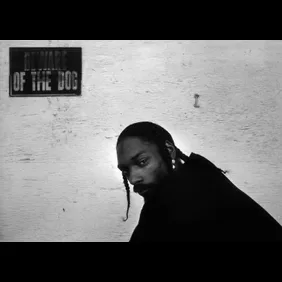
One thing that really stood out to me in the documentary was when you guys were talking about your friends who have passed away. In tattoo culture, a lot of people ink their friends or get portraits. But, Estevan for you, it’s like you're immortalizing these moments when you go to these neighborhoods and photograph these people. Can you guys talk to me about that?
EO: Yeah, it’s kind of a given. They say in this lifestyle there’s kind of like three places you’ll end up -- it’s jails, institutions or death. So, going into that environment and knowing that in the back of your head, you kind of are thinking like, yeah, I might take a picture of this guy and he might be in prison the next week or he might be in a rehab or killed. So it’s kind of like, you gotta go in there just thinking you’re just gonna take a picture. After that is when it's when you start thinking, “Oh, that guy’s a hothead. Or he’s on a good one.” Or something like that. Or “he might not make it to next week.” And that’s what happens to some of the people. They end up passing away or getting life in prison or something like that. And you have photos of a time in their life that bring good memories to their families, which is a cool feeling. I always post people that have passed away and I put up, “RIP to my homie Trigs” or Spanky or these other guys. Their family and friends always comment and are in the DMs saying, “thank you man for never forgetting my loved one or my friend” or “thank you for keeping their name alive.” I think that’s one thing that’s important, they want to be remembered. A lot of people that I talk to, I’ve had friends that say, “Aye if something happens to me, just don’t let my daughter ever forget about me. Just keep me and my memory in my daughter’s life.” And you’re like, yeah, no problem. In the moment, you’re thinking, “Man, shut up Julio. You’re tripping nothing’s gonna happen to you.” Then when they pass away you’re like, “Damn, now I have that obligation because I gave my word.” Every time I talk to certain people’s kids, I’m like, “your dad was like this or your dad was like that.” Or tell them a good story about their family member or their friend to keep their legacy alive in their life.
Cartoon, if you could elaborate on what Estevan said.
MC: I’ll do like a back piece for my friend and you know, one of my buddies, he OD’d and they take your artwork into the box, you know what I’m saying? It lasts longer. They might have some jewelry on, they might have some other things -- clothes or something to ‘em. But it’s a trip that your actual artwork is going to go back into the earth. And you know, sometimes, Estevan captures these guys so we have their picture. It’s a little bit of our way of, kind of, putting our flag into the ground, you know what I mean? Kind of just saying “we were here.” This is tribal for us. Kind of like an Aztec Warrior carving on the side of a pyramid, you know? It’s our way of leaving our mark. We were a part of something. We added to our community. We love our community and we just draw this way and he shoots this culture and he shoots a certain way. So we’re not just that, cause we like other s*** like we like foreign movies. People would never picture me and Estevan in like a Bali, Indian restaurant ordering butter chicken. We might be in some crazy Thai restaurant in Thai town or we might be in East LA in a crazy taco spot. It’s having an open mind, it’s accepting all good things. All things that are quality in detail. To be able to go to other parts of the world, represent where you came from but also respect and take in people from other lands, other tattoo cultures, other car cultures, other people that are sickos like us you know what I mean? We’re everywhere. That’s one thing about being tattooed is your kinship with everyone else that has tattoos all over the world. We’re renegades in a way where we’re members of a society that is underground like for cars lowered. We used to be looked at as riff-raffs and low-lives and drug addicts. Now, it looks like NBA stars and professional artists that are in contemporary art museums. So it’s come a long way, you know? We did that art show in Tokyo that Estevan was talking about. We thought that was it. We made it. We got our lowrider art in a gallery in Harajuku. Can’t be better than that. And for that time, we maxed that time out. I don’t know anybody’s that’s done it since the way we’ve done it -- out there at least. But we’re barely getting started, man. Me and E we’re fired up. We’re ready to take over the world, man. We’re ready to put our flag at the North Pole. We been to the South Pole now we’re going to the top so that’s it. We love to do it.
That’s what's up. Thank you guys so much, it has been an honor speaking to you legends.
EO: Thank you, bro.
MC: Appreciate you, man.
